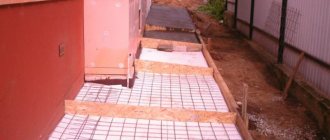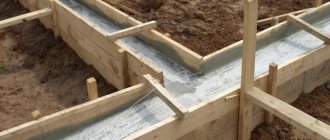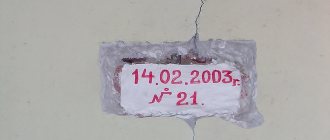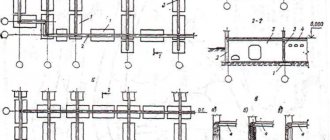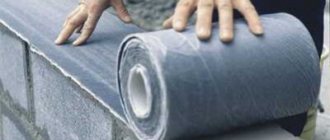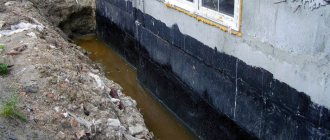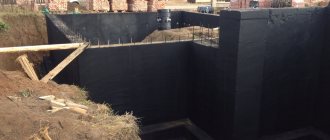In order for the building to last as long as possible, it is necessary to insulate the base and foundation from moisture during construction.
Waterproofing is the protection of part of the structure and surfaces from water; for the base, the procedure is carried out both inside and outside.
In addition to its main purpose, waterproofing helps save the building from other aggressive liquids, corrosion, and keeps materials intact.
Why do you need to protect the foundation of your house from water?
Waterproofing the base helps reduce or completely eliminate the ingress of moisture onto parts of the building and keep building materials intact. The main task of the procedure is to preserve the integrity of the building’s foundation for as long as possible and prevent destruction due to exposure to temperatures.
It is noteworthy that waterproofing work can be carried out both in advance, during the construction process, and after its completion.
The plinth is the external protection of the foundation; it creates a level for the lower floor, guides the laying of walls, and allows for the creation of additional basement rooms.
Basement waterproofing is necessary for:
Preservation of the building, durability of the building. Groundwater can wash away building materials, causing cracks to appear under pressure. As a result, the entire structure will be in danger of collapse.- When building materials come into contact with the ground, they enter into a chemical reaction, wear out faster, and the service life of the structure is reduced.
- Getting into microcracks and free cavities of the base (and then into the foundation), water molecules expand under the influence of low temperatures. This leads to disruption of the integrity of materials and cracks.
- The protection prevents moisture from entering the interior. Otherwise, the basement or basement rooms become damp, mold and other problems appear, reducing comfort and making it uninhabitable. The fungus quickly invades other spaces and can be dangerous to the health of residents.
- There are a lot of salts in groundwater and stormwater. They are deposited on the base, weaken the building mixtures, and lead to delamination and destruction of the structure. Salts leave a white coating that changes the appearance of the house and artificially ages it.
Site drainage is also important ; the foundation must be laid in soil freed from groundwater (a trench or hole for the foundation must be prepared before installing building materials), for which it is necessary to carry out geological development of the soil in advance.
Waterproofing foundations. Protection of basements from groundwater and dampness.
Protection of the foundation from groundwater.
To protect the walls of the house from groundwater, drainage (waterproofing) of the foundation is arranged.
Here are several ways to insulate foundations: –
A layer of cement-sand mortar, about 25 mm, with a composition of 1:2, is leveled, cemented, and dried.
Lay one layer of roofing felt or roofing felt on top. -Mastic is prepared from one part of heated bitumen to 1/2 part of fluff lime, sifted on a fine sieve. Lime can be replaced with dry sifted chalk, mixing it with resin in a 1:1 ratio. Hot mastic is applied in 2 layers. You can apply more layers, but you cannot apply fewer. The total thickness must be at least 8 mm. –
Lay two layers of roofing felt or two layers of roofing felt dry, but so that at the ends the seams overlap by at least 15 cm.
–
The most reliable insulation is with mastics (roofing felt with tar, roofing felt with bitumen).
The top of the foundation is covered with mastic and the first layer of rolled material is glued onto it, which is again covered with mastic, and the second layer is glued. For these works, roofing felt and roofing felt without sand and stone bedding are used. Waterproofing
is a dense waterproof layer made of paint, roll or other materials, designed to protect building structures or other objects from moisture from groundwater or other liquids.
Waterproofing is arranged in the form of several insulating layers of waterproof materials (roofing felt, roofing felt, etc.), laid on mastic (klebemass) or cement mortar, as well as in the form of plaster with a greasy cement mortar with the addition of ceresite. Waterproofing materials
are used in construction to protect against moisture, dampness, aggressive water, when installing drainage systems, and protecting the foundation.
For insulating particularly critical structures (tunnels, pipes, subways). Waterproofing materials are usually divided into the following types: - hot bitumen and asphalt mastics - cold bitumen mastics, emulsion pastes and cold asphalt mastics - furan and phenolic mastics and polymer concrete - cement-sand mortars with sealing additives Drainage systems
The basis of an effective drainage system is perforated drainage pipes , laid along the perimeter of the foundation in specially prepared trenches.
Water from the ground penetrates through the holes into the pipes and is then discharged into specially prepared containers. This ensures reliable waterproofing of the building foundation. In addition to the perforated pipe, a solid pipe is laid in the drainage system, which is designed to drain surface waste water from roofs or paved surfaces (storm drainage). Waterproofing can be rigid, coated and glued. Rigid
waterproofing is carried out by applying a dense waterproof layer of plaster 2-3 thick to the protected surface cm or by installing a lining made of waterproof concrete. Its top is brought to a level 0.5 m above the calculated groundwater level, and then waterproofing is arranged only from capillary moisture. The disadvantage of rigid waterproofing is the possibility of cracks appearing in it even with slight precipitation of the structure. with this, rigid waterproofing is carried out after the completion of the laying of the walls of the building and the installation of floors and roofs, when the settlement of the building basically ends.Coating
(
painting) waterproofing is a thin multi-layer shell applied to the insulated surface by coating with asphalt, bitumen, coal tar.
Coating waterproofing is usually installed on the outer surfaces of the masonry, since this waterproofing can only work successfully on the water pressure side. Coating insulation is easily destroyed when the structure is deformed; in addition, it wears out quickly. In this regard, coating waterproofing is recommended to be used only in cases where, due to operating conditions, its periodic repair is possible. Pasted
- this insulation is made from several layers of rolled waterproofing material, glued to the enclosed surface using waterproof plastic mastics. As rolled materials for this purpose, cardboards impregnated with petroleum bitumen (roofing felt, glassine, hydroisol), fabrics (metroizol, metrobit), and cardboards treated with coal tar (tar paper, roofing felt leather) are used. A serious disadvantage of adhesive waterproofing is the high labor intensity of its production and the inability to effectively mechanize it. Fig.1. Waterproofing of a basement-free building with a base height of more than 0.6 m, 1 sidewalk; 2-horizontal waterproofing; 3 – plank floor; 4 – preparation for floors; 5 – coating with bitumen; 6- wall; 7 – foundation
Attentiveness test Only 5% of users score 100 points. How many points will you get?
1). The simplest case is protection from capillary moisture.
At a height of 15-20 cm from the top of the blind area, along the leveled horizontal surface of the walls, a continuous waterproof layer of 1...2 layers of rolled material on bitumen mastic is arranged (Fig.)
Rice. 14.14. Insulation of walls from dampness and capillary moisture:
a – wall of a building without a basement; b – basement wall; 1- cement mortar or rolled material; 2 – coating with bitumen twice.
2). If the groundwater level is below the basement floor (Fig. 14.14 b), then insulation from dampness is used to protect the foundations.
To do this, the outer surface of the recessed walls is coated with hot bitumen 1…2 times and roll insulation is laid in the wall at a level below the basement floor.
3). If the water level is higher than the basement floor level, then waterproofing is carried out in the form of a continuous shell that protects the recessed room from below and on the sides.
– Vertical waterproofing is usually glued to the outside of the foundation, because in this case, under the influence of groundwater pressure, the insulation is simply pressed against the insulated surface.
To protect the insulation from mechanical influences (for example, during backfilling), it is fenced from the outside with a protective wall made of brick, concrete or blocks. The gap between the wall and the waterproofing is filled with liquid cement mortar.
– Horizontal waterproofing is glued onto the preparation surface leveled with cement screed and protected on top with a cement or asphalt layer t=3...5cm.
4). Corrosion protection.
– In slightly aggressive waters, make a clay castle from well-crushed and tightly compacted clay along the entire height of the protective wall and on the sides of the foundations (Fig. 14.16)
Consequences of not insulating your home from moisture
The basement of the building is exposed to water from both the soil and the atmosphere. This is the wettest part of the building. The lack of waterproofing affects not only the foundation, but also the walls of the building.
What are the consequences of lack of basement waterproofing:
- If this part of the building is made of brick, it absorbs moisture very well. It rises from the ground up the structure and destroys it from the inside. Finishing materials (tiles, panels, etc.) split and fall off in pieces. The external attractiveness of the building is lost.
- Penetration of moisture into the walls threatens to damage the thermal insulation of the room (the insulation gets wet, begins to rot and collapse). Heating the house will become difficult and will require a lot of resources.
- Water penetrates the cracks in the concrete foundation, erodes it and destroys it. It’s good if the base mixture initially contains waterproofing elements, the appearance of cracks will be delayed for some time. But such a building will wear out faster.
- The concrete base also splits and is torn from the inside by moisture entering through the cracks. The reliability of the building is lost, traces of salt remain on the outer part, the paint falls off along with the plaster.
- It becomes impossible to stay or store anything inside the basement floor. Biological microorganisms are difficult to remove; they spread throughout all rooms, the first floor and walls of the house are especially affected.
Waterproofing the base must be done in three places: in contact with the foundation, with the ground and with the wall. Then the structure will be reliably protected.
External foundation protection
Ideally, protection of the foundation from destruction by moisture should be applied from the outside. This is usually done during the construction of the building. If the house has already been built, then external work is possible only after the foundation has been dug around the perimeter.
It is imperative to put waterproofing between the foundation and the wall.
Before protecting the foundation from moisture, let’s consider which materials are suitable for outdoor use:
- bitumen rolls;
- polyurea;
- bitumen mastics;
- PVC membranes.
It must be taken into account that the hydraulic barrier will be covered with earth. It contains stones that, under high pressure, can damage the protective layer. The material used must be strong, so liquid rubber, acrylic mastics and thin polymer films are not suitable for these purposes.
Bitumen rolls are the most common type of foundation protection from water.
Black bitumen mastic is used as a primer (preparatory layer). It is applied to the work surface with a brush or roller in one layer. Then bitumen rolls are fused onto the mastic. It is a self-adhesive material that becomes sticky when heated with an open flame. Rolls are laid in at least two layers with overlapping seams.
Polyurea is applied by spraying. The working surface must first be cleaned of dust. The protective liquid polyurethane composition creates a strong, waterproof film that adheres securely to concrete. It is advisable to apply in several layers.
For installation outside the foundation, thin PVC film cannot be used. A special PVC membrane with pimples is suitable for these tasks. Hemispherical pads protect against load and serve to connect sheets. The waterproofing is attached to the foundation walls mechanically (using studs).
What materials are used, how to choose them correctly?
Materials for basement waterproofing differ in properties. The choice is made based on performance characteristics:
Polymer compositions .
Their physical properties are similar to rubber; they are used more often on the outside, where the base comes into contact with the ground and the atmosphere. Advantages: tolerates temperature changes well, does not crack in the cold, it is not necessary to clean the surface before application, they are inexpensive.- Mixtures and primers .
These materials are able to penetrate into the deep layers of the base, making them considered the best option for porous concrete and brick. Used for internal and external work. Apply using painting supplies (brushes, rollers). The base with it becomes heat-resistant and is not susceptible to external influences. It can only be applied at above-zero temperatures; before the procedure, you need to protect your respiratory system and exposed skin. The compounds are applied to the cleaned surface. For better penetration into concrete or brick, the surfaces are leveled. - Coating, mastics . Cement-polymer based materials. It is applied from above to the base, suitable for any surface, no preliminary preparation is required. Disadvantage: bitumen-based waterproofing is short-lived and needs to be updated periodically. Based on cement and polymers, it lasts longer and tolerates temperature changes well.
- Rolls: roofing felt, roofing felt, film, membrane . They are convenient to use when laying the foundation. The material is left in reserve in a trench or hole, and then the base is covered with it. This way the entire base of the building is protected from water, even if it is very close. Rolled coverings can withstand the pressure of melt water, are inexpensive and environmentally friendly. The most popular option is “Izospan A base”. This waterproofing is capable of releasing vapors to the surface, maintaining fresh air inside the basement.
- Injections. This is a special type of basement waterproofing; the solution is injected into the surface. Such work is carried out exclusively by specialists; the method is effective if the waterproofing procedure has not been carried out in advance; it is more expensive than others.
A brick base requires waterproofing, since the porous material absorbs a lot of moisture and quickly collapses.
Suitable for:
- mixtures,
- coating,
- processing with polymer compounds.
This way the brick will retain its useful properties: breathability, heat retention and visual appeal. It is recommended to carry out the procedure in advance and begin preparing from the moment the foundation is laid.
Foundation waterproofing device. Materials used, technologies, advice on their selection
Foundation waterproofing in modern low-rise construction is an almost integral part of the zero-cycle construction process.
This is due to the presence of moisture in the soil in the vast majority of territories of our country. Water itself is not particularly dangerous for concrete; on the contrary, in a slightly moistened state, concrete continues to gain strength over many years. However, there are three big “BUTs”. Firstly, concrete has the property of capillarity. This is the rise of water up through the smallest pores located inside the material. The simplest example of this phenomenon is wetting a piece of sugar slightly lowered into a glass of tea. In construction, the capillary rise of water leads (unless, of course, waterproofing is done) to the penetration of moisture, first from the outer layers of concrete to the inner ones, and then from the foundation to the walls that stand on it. And damp walls mean increased heat loss, the appearance of fungi and mold, and damage to interior finishing materials.
Secondly, a modern foundation is still not concrete. This is reinforced concrete, i.e. it contains reinforcement, which upon contact with moisture begins to corrode. In this case, the iron in the reinforcement turns into iron hydroxide (into rust), increasing in volume by almost 3 times. This leads to the formation of strong internal pressure, which, when reaching a certain limit, also destroys the concrete from the inside.
Thirdly, we do not live in the tropics, and sub-zero temperatures for our climate in winter are the norm. As everyone knows, when water freezes it turns into ice, increasing in volume. And if this water is deep in the concrete, the resulting ice crystals begin to destroy the foundation from the inside.
In addition to the above, there is another danger. There are often cases when groundwater in a site contains chemical elements (salts, sulfates, acids...) that have an aggressive effect on concrete. In this case, the so-called “concrete corrosion” occurs, leading to its gradual destruction.
High-quality waterproofing of the foundation allows you to prevent all these negative processes. And how it can be accomplished will be discussed in this article.
By and large, you can protect the foundation from moisture in two ways:
1) when pouring, use the so-called bridge concrete with a high coefficient of water resistance (various grades of concrete and their characteristics will be discussed in a separate article);
2) cover the foundation with a layer of some waterproofing material.
Ordinary developers most often now follow the second path. What is this connected with? At first glance, it would seem that it could be simpler - I ordered waterproof concrete from the factory, poured it and that’s it, sit back and be happy. But in reality, not everything is so easy, because:
- the increase in the price of a concrete mixture with an increase in the coefficient of water resistance can reach 30% or more;
- not every plant (especially a small one) can produce a grade of concrete with the required water resistance coefficient, and attempts to produce such concrete on your own can lead to unpredictable consequences;
- and most importantly, there are problems with the delivery and placement of such concrete (it has very low mobility and sets quite quickly, which in most cases limits the possibilities of its use).
The use of a waterproofing coating is accessible to everyone and, with certain skills, can be done even with your own hands.
Materials for foundation waterproofing
All materials used to protect foundations from moisture can be divided into the following groups:
- coating;
- sprayable;
- roll;
- penetrating;
- plastering;
- screen waterproofing.
Let's take a closer look at each of them.
I) Coating waterproofing is a bitumen-based material that is applied to the surface (often in 2-3 layers) using a brush, roller or spatula. Such coatings are usually called bitumen mastics. You can make them yourself or purchase them ready-made, poured into buckets.
Recipe for homemade bitumen mastic: buy a briquette of bitumen, split it into small pieces (the smaller, the faster it will melt), pour into a metal container and put on fire until completely melted. Then remove the bucket from the heat and add waste oil, or better yet, diesel fuel (20-30% of the volume of mastic), and mix everything thoroughly with a wooden stick. How this is done is shown in the following video:
Ready-made bitumen mastic is sold in buckets. Before use, for more convenient application, it is usually mixed with the addition of some solvent, for example, solvent, white spirit, etc. This is always indicated in the instructions on the label. There are several manufacturers of such mastics with different prices and different characteristics of the finished coating. The main thing when buying them is not to make a mistake and not take material, for example, for roofing or something else.
Before applying bitumen mastic, it is recommended to clean the concrete surface from dirt and prime it. The primer is made with a special composition, the so-called bitumen primer. It is also sold in stores and has a thinner consistency than mastic. Coating waterproofing is applied in several layers, each of which after the previous one has hardened. The total thickness of the coating reaches 5 mm.
This technology is one of the cheapest compared to those described below. But it also has its drawbacks, such as the short durability of the coating (especially when prepared independently), the long duration of the work and high labor costs. The process of applying mastic with a brush is shown in the following video:
II) Sprayed waterproofing or so-called “liquid rubber” is a bitumen-latex emulsion that can be applied to the foundation using a special sprayer. This technology is more progressive than the previous one, because allows you to perform work with higher quality and in a fairly short period of time. Unfortunately, mechanization of work significantly affects its cost.
The characteristics of liquid rubber and the process of its spraying are shown in the following video:
III) Roll foundation waterproofing is a bitumen or polymer modified material, previously applied to any base. The simplest example is the well-known roofing felt with a paper base. In the production of more modern materials, fiberglass, fiberglass, and polyester are used as the basis.
Such materials are more expensive, but also much higher quality and durable. There are two ways to work with roll waterproofing - gluing and fusing. Gluing is carried out on a surface previously primed with a bitumen primer using various bitumen mastics. Fusing is carried out by heating the material with a gas or gasoline burner and then gluing it. How this is done is shown in the following video:
The use of rolled materials significantly increases the durability of foundation waterproofing compared, for example, with coating materials. They are also quite affordable. The disadvantages include the difficulty of performing the work. It is quite difficult for an inexperienced person to do everything efficiently. You also can't do the job alone.
The appearance of self-adhesive materials on the market several years ago made it much easier to work with roll waterproofing. How to protect the foundation with their help is shown in the following video:
IV) Penetrating waterproofing is a coating of concrete with special compounds that penetrate 10-20 cm into its thickness through pores and crystallize inside, thereby clogging the passages for moisture. In addition, the frost resistance of concrete and its protection from chemically aggressive groundwater increases.
These compounds (Penetron, Hydrotex, Aquatron, etc.) are quite expensive and have not found wide application for complete waterproofing of the foundation in a circle. They are more often used to eliminate leaks in already built and operated basements from the inside, when it is no longer possible to repair the waterproofing from the outside using other methods.
The following video describes the properties of penetrating materials and their correct use in more detail:
V) Plaster waterproofing is, by and large, a type of coating insulation, only here it is not bituminous materials that are used, but special dry mixtures with the addition of waterproof components. Prepared plasters are applied with a spatula, trowel or brush. For greater strength and to prevent cracks, a plaster mesh can be used.
The advantage of this technology is the simplicity and speed of application of materials. The downside is the low durability of the waterproofing layer and lower water resistance compared to the materials described above. The use of waterproofing plasters is more appropriate for leveling the surfaces of foundations or, for example, for sealing seams in foundations made of FBS blocks, before subsequently covering them with bitumen or roll waterproofing.
VI) Screen waterproofing - this is sometimes called the protection of foundations from moisture using special swelling bentonite mats. This technology, which is essentially a replacement for the traditional clay castle, appeared relatively recently. The mats are attached to the foundation with dowels overlapping each other. More details about what this material is and its properties are discussed in the following video:
How to choose waterproofing for the foundation?
As you can see, currently there is a huge amount of all kinds of waterproofing materials to protect foundations. How not to get confused in this variety and choose exactly what is suitable for your specific conditions?
First, let's look at what you need to pay attention to when choosing waterproofing:
- presence or absence of a basement;
- ground water level;
- type of foundation and method of its construction
The different combination of these three factors determines which waterproofing should be preferred in this case. Let's look at the most common options:
1) Columnar foundations.
A columnar bored foundation can only be protected with rolled waterproofing. To do this, cylinders of the required diameter are pre-rolled from it, fixed with tape, lowered into drilled wells, reinforcement cages are installed and concrete is poured.
The cheapest option is to use regular roofing felt. If it is with sprinkles, it is better to roll it with the smooth side out so that in winter, when it freezes, less soil will stick to it. It is advisable to ensure that the thickness of the waterproofing along the entire circumference is at least two layers.
When using asbestos or metal pipes for a columnar foundation, they can first be coated with any coating bitumen waterproofing in at least 2 layers.
If you are going to build a grillage on pillars, before pouring it, for greater reliability, the tops of the pillars also need to be covered with coating waterproofing (even better, not as in the figure below, but directly from the ground). This will prevent possible capillary rise of water from the soil into the grillage.
2) Shallow strip foundations (MSLF).
MZLF, by their nature, should always be located above the groundwater level. Therefore, for its waterproofing, ordinary roofing material and bitumen mastic are quite enough to prevent capillary suction of moisture from the soil.
The figure shows one of the working options. Before installing the formwork, a folded roofing material with a small outlet is spread on the sand cushion. Then, after pouring and setting of concrete, the side surfaces of the tape are covered with coating waterproofing. Above the level of the blind area, regardless of what kind of base you have (concrete or brick as in the figure), cut-off waterproofing is done by gluing 2 layers of roofing material onto bitumen mastic.
3) Recessed strip foundations (house without a basement).
Waterproofing of a buried strip foundation, regardless of whether it is monolithic or made of FBS blocks, when the house does not have a basement, can be done according to the scheme shown above for MZLF, i.e. the bottom is rolled material, and the side surfaces are covered with coating insulation.
The only exception is the option when the foundation is not poured into the formwork, but directly into a dug trench (as you understand, coating cannot be done). In this case, before installing the reinforcement frame and pouring concrete, the walls and bottom of the trenches are covered with rolled waterproofing with gluing or fusing joints. The work is certainly not very convenient (especially in a narrow trench), but there is nowhere to go. This was discussed in the article “Strip foundation - calculation and construction with your own hands.”
Also, do not forget about the layer of cut-off waterproofing above the level of the blind area.
4) Recessed strip foundations, which are the walls of the basement.
The use of coating and spraying materials to waterproof basement walls from the outside is permissible only in dry sandy soils, when groundwater is far away and the perched water quickly drains through the sand. In all other cases, especially with a possible seasonal rise in groundwater, it is necessary to do roll waterproofing in 2 layers using modern materials based on fiberglass or polyester.
If the foundation is made of FBS blocks, before waterproofing it, it is advisable to cover the seams between the individual blocks with a plaster waterproofing mixture, at the same time leveling the surface.
5) Slab foundations.
Foundation slabs (basement floors) are traditionally protected from moisture from below by gluing two layers of rolled waterproofing onto a pre-poured concrete preparation. The second layer is spread perpendicular to the first. This was discussed in more detail in the article “Slab foundation - calculation and construction with your own hands.”
To avoid damaging the waterproofing layer during subsequent work, try to walk on it as little as possible, and cover it with extruded polystyrene foam immediately after installation.
At the end of the article, let us pay attention to two more points. Firstly, when the groundwater level rises above the level of the basement floor, you need to make drainage (a system of drainage pipes laid around the perimeter of the house and wells for inspection and pumping out water). This is a big topic that will be discussed in a separate article.
Secondly, the layer of vertical waterproofing of the foundation requires protection from damage that can occur during backfilling and soil compaction, as well as during frost heaving of the soil in winter, when it sticks to the waterproofing and pulls it up. This protection can be achieved in two ways:
- the foundation is covered with a layer of extruded polystyrene foam;
- install special protective membranes that are currently commercially available.
Most builders prefer the first method, because... it allows you to “kill two birds with one stone” at once. EPS also protects waterproofing and insulates the foundation. Foundation insulation is discussed in more detail here...
Processing methods
There are two types: horizontal and vertical waterproofing. Horizontal waterproofing between the plinth and the foundation is necessary if the plinth is also the base of the wall. It protects against moisture penetration from the foundation above and preserves the integrity of the walls for a long time. If the base is a continuation of the foundation, the procedure is optional.
This can be done if the base of the building is made of:
- stone,
- bricks,
- blocks,
- Concrete products
If the base and foundation are a monolithic concrete or rubble concrete structure, it cannot be waterproofed horizontally.
The moisture protection on the basement floor must be connected to the base protection, the seam between them is treated with a torch or mastic. Rolled materials are used here: roofing felt or roofing felt.
Vertical waterproofing - covering the outside and inside of the base , protection from moisture from the soil and atmospheric phenomena. You can use any of the materials listed above; mixtures, coatings or polymers are most convenient. Apply from the bottom of the soil to the beginning of the wall.
It is carried out together with horizontal waterproofing; at the junction, the materials are carefully combined.
The need to waterproof the foundation
If the house is being built in a swampy area or where the groundwater level is always high, waterproofing is definitely needed. But if the site chosen for construction has dry soil, is it necessary to use moisture protection technology? In this situation, everything will depend on the type of foundation.
When waterproofing is not needed
When installing a pile-screw foundation, protection from moisture will not be required, but only if industrial piles are used. If the material is made independently, waterproofing will still be required.
A foundation built from a shallow-depth tape does not require additional protection from moisture, but there is a small exception here: if there is no blind area, then waterproofing will be needed.
When you can't do without moisture protection
Waterproofing must be installed when installing slab, strip and column foundations, as well as if a basement floor is being built. If the soil under the building has even a little moisture, and at the same time comes into contact with the surfaces of the walls in the basement, where there is no protection from moisture, fungus and mold will soon appear in the room.
Technology of work from inside and outside
Comprehensive moisture protection is carried out inside and outside the base. External insulation is more important, since the threat here is higher; from the inside, water penetration into the surface of the base occurs during the operation of the room.
Horizontal installation
Rolled materials are laid on the foundation before laying the base. How to make a coating with your own hands:
- Level the surface, remove all debris, seal cracks and crevices with connecting material.
- Cover a flat surface with bitumen mastic.
- Lay out the roofing material evenly, pressing it tightly against the mastic. Keep the overlap approximately 20 cm; there should be no air under the coating layer.
- At the joints, melt the roofing material with a gas burner; the seams are tight, without holes.
Vertical coating
You will need: bitumen mastic, bitumen primer. Instructions:
clean the surface from dust and debris, level it;- walk over the surface with a primer (bitumen primer) so that the materials adhere successfully;
- when the primer has dried, apply the mastic evenly and uniformly - the first layer should dry completely;
- apply a second coat.
After about 10 years, mastic may crack under the influence of temperatures. It is necessary to monitor the condition and carry out repairs on time.
Vertical roll
Often the coating is combined with rolled masonry, so the waterproofing layer is more reliable. You will need: rolled roofing felt, mastic, primer.
Procedure:
- Clean and level the surface.
- Apply primer and wait until dry.
- Apply the first even layer of mastic.
- Before joining the roofing felt and mastic, heat the rolled material on a gas burner until soft. This way it will adhere better to the coating.
- Apply roofing felt overlapping and melt the seams using a torch. There should be no gaps left.
- For reliability, it is recommended to apply 2-3 layers of roofing felt. Treat all joints with a torch or mastic.
In an already built house, waterproofing can be laid on top. First you need to clean the surface and degrease it with a primer. After applying all the layers sequentially, cover the top with facing materials (tiles, bricks). Reliably process joints.
But more often they use injection waterproofing, which is carried out by professional construction teams. The solution is injected into the finished base, fills the cracks and hardens.
Internal using mixtures
Inside the base, mixtures and primers are often used. They penetrate into microcracks in the coating, harden there and prevent moisture from seeping through.
Instructions:
- Level the surface and degrease with primer.
- Moisten the surface for better penetration of the mixtures.
- Apply penetrating material.
The penetrating material is suitable for concrete plinth walls; an adhesive primer (concrete contact) is used.
For bricks, silicon-based compounds are used, applied with a roller or brush. If you plan to apply coating to the brick, you first need to plaster the surface.
Types of waterproofing
Protection of the foundation from moisture can be horizontal or vertical. For both types of waterproofing, different materials can be used, which will be discussed further.
Horizontal
The peculiarity of this insulation is that it is performed only during the construction of the foundation of the house. First of all, it protects the foundation from the effects of groundwater.
The method and material for its manufacture depend on the type of base and the characteristics of the soil. Under a wooden house, horizontal protection from moisture is mandatory, regardless of what kind of foundation will be built.
The horizontal insulation option is made from a variety of membrane materials on a bitumen, polymer or synthetic basis. The most commonly used material for this type of protection is roofing felt. If a basement is planned in the house, most often horizontal waterproofing will be carried out simultaneously along the upper and lower sides of the floor slab.
Vertical
Vertical moisture protection can be done in an already built house. This type of protection is needed to prevent groundwater from affecting the foundation material of the house.
As mentioned above, not all types of foundation require such insulation. However, when constructing a strip and column base of a building, vertical waterproofing is always needed. To install vertical insulation, you can use different methods and materials, which will be discussed in more detail below.
Pasted insulation
For this type of protection, roll materials are used, which are attached by fusing or gluing. Fused materials have an adhesive layer that heats up and sticks to the surface. To secure the material without an adhesive base, it is necessary to use bitumen mastic, which will act as a connecting component.
The following materials are used to perform adhesive insulation:
- Glassine. The average price for 1 roll is 150 rubles. The material is made on the basis of thick cardboard, which is impregnated with a bitumen composition. Glassine does not make the most reliable and durable insulation, but it is a great way to save money;
- Ruberoid. The average price for 1 roll is 350 rubles. This material is a leader among rolled types of insulation, as it has a low price and a long service life;
- Bitumen-polymer material. This is the most reliable and durable option, but it costs more than others. The average price for one roll of bitumen-polymer material is 1,000 rubles. As an example of such insulation, the following common options can be cited: TechnoNIKOL, Linokrom, Gidroizol, Bikrost and Stekloizol.
Coating insulation
To insulate the foundation in this way, bitumen-based mastic is most often used (average price - 350 rubles per 20 liters). In addition to simple bitumen compositions, you can buy more modern options in construction stores:
- Polymer resins;
- Bitumen-polymer resins;
- Bitumen-rubber mastics.
Conventional bitumen mastic differs from modern compositions in that it is unstable to low temperatures (it cracks in the cold).
More modern mixtures have additional additives that allow them to be resistant to cold. They have only one drawback - the high price (on average from 3,000 rubles for 20 liters).
Penetrating insulation
Penetrating insulation prevents moisture from entering the concrete capillaries, thereby increasing the strength of the top layer of this material.
On average, the depth of penetration of special mixtures into concrete is 15-25 cm.
This insulation option is only suitable for concrete foundations. If you use penetrating compounds on brick or stone, they will not work.
The most popular compositions for penetrating insulation are these:
- Penetron (on average 1,500 rubles per 5 kilogram);
- Peneplug (on average 1,200 rubles per 5 kilogram);
- Hydrohit (on average 1,000 rubles per 5 kilogram);
- Penecrit (on average 1,300 rubles per 5 kilograms).
It is recommended to use this protection technology for new homes, since penetrating mixtures must be applied to thoroughly cleaned, degreased and smooth surfaces.
Mounted insulation
Mounted waterproofing is used mainly for strip foundations, if it is necessary to protect the basement from high groundwater pressure.
The best option for mounted insulation is considered to be a steel caisson. This option involves lining the walls and floor of the basement from the inside using steel sheets, the thickness of which is 4-6 mm. This is a rather expensive option, so it is used extremely rarely.
Possible process errors and ways to eliminate them
Common mistakes:
- External waterproofing was not carried out in advance. To do this after construction, when damage has already begun, you will need to open up part of the soil to the base of the base and drain groundwater (if it has reached the surface). Next, clean the damaged surfaces and strengthen them with reinforcement and cement. Apply waterproofing and cover with facing materials (or paint).
- No stripping or priming. These important process elements should not be skipped. The fact that a mistake has been made will become known with the appearance of leaks or damage to the base. Waterproofing will need to be repeated on the finished structure.
- Selection of low-quality materials. The suitability and interoperability of materials must be considered in advance.
The result of errors is the appearance of cracks.
They are eliminated like this: the crack is cleaned from the inside with an iron brush and filled with primer. If the crevice is wide, bitumen mastic is used. Afterwards it is treated with cement until it dries, and waterproofing is carried out over the entire surface of the base.
Vertical waterproofing
Vertical waterproofing is a method of combating high humidity, in which the walls of the building’s base and basement are strengthened. It is possible both at the construction stage of the facility and during preparation for construction.
Vertical waterproofing is carried out from the outside of the base of the building and is applied to the level of the sidewalk or blind area. At the same time, there are several types of vertical waterproofing.
Bitumen waterproofing
Using bitumen waterproofing is considered the simplest and most affordable method. The bottom line is that contractors treat the foundation with bitumen mastic, as a result of which the substance penetrates into all the cracks and gaps, filling them. This feature of bitumen mastic helps protect against moisture, and, therefore, ensures the strength of the base of a wooden house.
If you bought a bitumen block, you should melt it to a liquid consistency in some container, after which you need to apply the mixture in several layers (from two to four). It is important to remember that the surface must be treated with melted bitumen mastic at one time, because repeated heating of the substance will lead to the loss of beneficial properties.
Pros:
- ease of use;
- availability of building material;
- low cost.
Minuses:
- not a very high level of waterproofing;
- relatively short service life of mastic - up to 15 years.
Roll waterproofing
Roll waterproofing of a wooden house using roofing felt is the application of a layer of one of its types: techno- or isoelast. This method can exist either independently or as a supplement to the previous type of insulation. The process of installing protection is very similar to laying a roof. You need to take a special burner, heat the roofing material and overlap it on the base, which has already been treated with a bitumen mixture. The joints of the roofing felt are also heated and fixed.
Pros:
- long service life - up to 50 years;
- acceptable price.
The downside is that the process is quite difficult to complete on your own.
Waterproofing with plaster
Waterproofing with plaster involves creating a homogeneous mixture to strengthen a wooden house from the plaster itself with the addition of components that are resistant to any level of moisture. The base is impregnated by applying the substance with a spatula to the foundation walls. This composition not only protects against the ingress of groundwater, but also levels the very foundation of the object.
Pros:
- low cost of materials;
- ease of application of waterproofing.
Minuses:
- short service life - up to 15 years;
- the possibility of cracks forming over time;
- insufficient level of protection against moisture.
Liquid rubber
If you decide to use liquid rubber, then the base will be reliably protected, because it sprays perfectly and serves your family for a long time. Before applying the substance, the foundation and base should be treated with a special primer.
There are two types of liquid rubber - elastomix and elastopaz. The first type is applied in one layer and hardens within a few hours. After opening the container with the mixture, the substance will no longer be stored for a long time; it must be completely used before setting. As for the second type, the mixture can be applied in two dense layers, and the remainder will be stored in the container for some time.
Protecting the foundation is a very important stage when building a house, since the further operation of the building will depend on how it is done. If everything is done correctly, the house will last for many years.
Trust me, these are just some tips on how to protect the basement and foundation of your home. Experts will help you determine, already during the initial preparation, what type of moisture insulation is best for the basement of your home.
Average prices for the country
The price depends on the type of work. Average cost of work in Russian cities:
| Type of work | Moscow, r/m2 | St. Petersburg, r/m2 | Regions, r/m2 |
| Vertical using roll materials, coating, penetrating | 650 | 600 | 500 |
| Injection | 4500 | 3400 | 3300 |
| Horizontal | 600 | 550 | 500 |
The final price depends on the complexity, volume, materials and qualifications of the workers.
Everything you need to know about building a basement can be found in this section.
